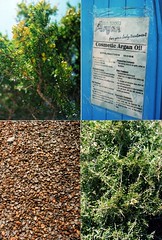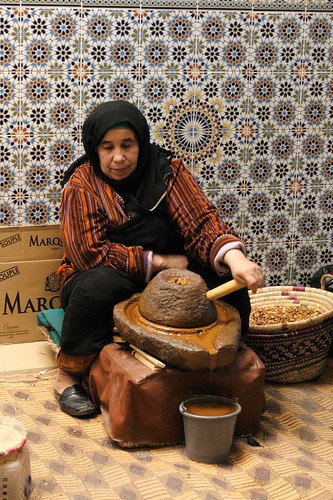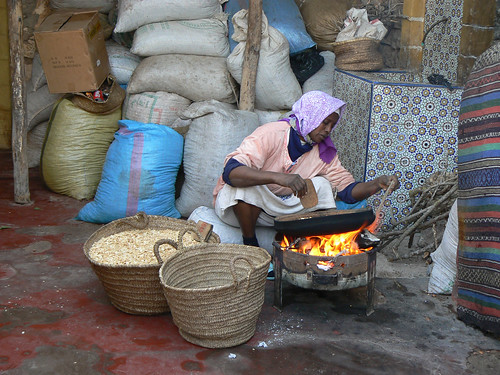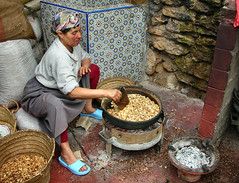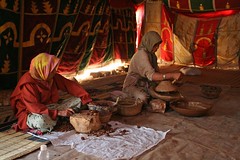Argan Oil
by hannahgrrrl
Labels: argan oil, argan oil cooperative, argan tree
What's Argan Oil?
 What's Argan oil?
What's Argan oil?
Argan oil comes from the argan tree (Argania Spinosa), an endemic tree in southwestern Morocco. Used locally for centuries, nowadays argan oil is attracting increasing interest from outside of Morocco, thanks to both its cosmetic and dietary properties.
Ancestral method of argan oil extraction
Once ripe, argan fruits are typically collected by women and brought to village where they are broken down the traditional way between two stones, (left shells are usually used to feed needed fire).
After getting rid of the shells, the almonds are then closely crushed along with some water in a handmade mill called Azerg. Then the obtained dough is kneaded repeatedly and pressed by hands to extract argan oil. The residue is conserved and used to feed own livestock. Using this traditional way, it takes more than 10 hours to produce just one liter of argan oil. Argan almonds are gently roasted before being crushed yielding an oil used in daily kitchen recipes. For cosmetic purposes, we should use argan oil that comes from the not roasted almonds.
Argan almonds are gently roasted before being crushed yielding an oil used in daily kitchen recipes. For cosmetic purposes, we should use argan oil that comes from the not roasted almonds.
The production of Argan oil has always been a merely matter of those Moroccan local families. But recent exploitations of argan fruit has taken it to an even more crafty, let alone industrial level because of the publicity that has been made on the virtues of argan oil. Local women's cooperatives have joined forces to produce more of this miraculous oil the traditional way.
A part of argan oil production is intended for export to Europe, Canada and the United States, which reinforces the local socio-economical role of this magically precious oil. Some of argan oil production is meant for high level cosmetic usage after further processing in laboratories.
A summary of Argan oil benefits
- For centuries, Argan oil has been used locally for therapeutic, cookware and cosmetic purposes, today the whole world is appreciating this oil.
- Argan oil is highly rich in essential fatty acids oleic and lineoic acids (47%) as well as in vitamin E (60-90mg/1OOg) , which positively boost our skin regenerating capabilities.
- It repairs and protects the skin against droughts and external aggressions, preventing its premature aging thanks to its essential fatty acids.
- Argan oil vitamin E richness, gives its antioxidant qualities
- It protects muscles from degeneration associated with aging.
- It can be used both for internal and external purposes.
- some argan oil internal usages: Massage, for rheumatism, against hair loss, to eliminate dandruff, against acne, burns, wrinkles, to protect against skin drying.
- some argan oil internal usages: positive effect against cholesterol and atherosclerosis.
- some argan oil culinary usage: in dressings, its aroma couples very well with crudites.
- Its nutty after-taste enhances so many dishes: whether with fish or goat's cheese, with puréed sweet potatoes or a salad of carrots and oranges.
- A simple argan oil drizzle will enliven your soups, cooked dishes and even desserts.
- It adds a touch of nut and sesame, bringing an oriental flavor to your cooking,
- It enhances the prostaglandins synthesis. Argan oil contains no cholesterol, which makes it very suitable in the context of any cholesterol-free diet.
- It protects the cardiovascular system.
- For a cosmetic use, it softens the skin, revitalizes the tired and wrinkled parts by rehydrating and giving the skin its lost youthful elasticity.
- Argan oil is also highly effective as a relief middle in cases of burns, scars and the like.
- Argan oil has a strengthening effect for nails and hair.
- Argan oil is widely used in the local recipes as well as in traditional medicine as a treatment of skin diseases such as acne and chickenpox (varicella).
- Currently, it is used as a medicinal product and active ingredient in many cosmetics and increasingly used by international and famous beauty specialists.
 Argan oil constitutes an important source of lipidic fat. It's estimated that argan oil production is between 3,000 and 4,000 tons, that is 1.6 percent of total Morocco oil consumption.
Argan oil constitutes an important source of lipidic fat. It's estimated that argan oil production is between 3,000 and 4,000 tons, that is 1.6 percent of total Morocco oil consumption.You would appreciate knowing that to produce just one liter of argan oil you need, in good years, no less than eight argan trees. A long day of labor is needed to get such precious liter of oil : argan fruits drying, pulping, getting rid of argan nuts shells one by one and by hand, crushing and grinding roasted almonds the traditional way and finally hand-persing and extracting this legendary oil. Added to argan fruit scarcity, comes the difficulty of production. (see argan oil production steps in photos).
Health Benefits of Argan Oil
Argan Oil Health Benefits Argan oil is rich in essential fatty acids, especially linoleic acid, a precursor of vitamin E giving its moisturizing, strong antioxidant and skin anti-aging properties.
Argan oil is rich in essential fatty acids, especially linoleic acid, a precursor of vitamin E giving its moisturizing, strong antioxidant and skin anti-aging properties.
Long observed empirically, the beneficial effects, moisturizers and restructurability of argan oil have since been confirmed and explained scientifically.
By its content of essential fatty acids (EFAs), argan oil makes it possible to correct deficiencies that inevitably occur with age, and which result in dehydration and loss of skin elasticity. Argan oil and combat skin aging. Argan oil is also rich in tocopherols (vitamin E) at the rate of 700 mg per kilogram, or more than twice as much as olive oil (320 mg / kg). The latter, as well as polyphenols also contained in the argan oil, are natural antioxidants and anti-free-radicals.
Argan oil stimulates intracellular oxygenation, neutralizes free radicals and protects the soft tissue. Its skin application restores the skin and increases the nutrient content of skin cells.
Argan oil benefits summary
- For centuries, Argan oil has been used locally for therapeutic, cookware and cosmetic purposes, today the whole world is appreciating this oil.
- Argan oil is highly rich in essential fatty acids oleic and lineoic acids (47%) as well as in vitamin E (60-90mg/1OOg) , which positively boost our skin regenerating capabilities.
- It repairs and protects the skin against droughts and external aggressions, preventing its premature aging thanks to its essential fatty acids.
- Argan oil vitamin E richness, gives its antioxidant qualities
- It protects muscles from degeneration associated with aging.
- It can be used both for internal and external purposes.
- some argan oil internal usages: Massage, for rheumatism, against hair loss, to eliminate dandruff, against acne, burns, wrinkles, to protect against skin drying.
- some argan oil internal usages: positive effect against cholesterol and atherosclerosis.
- some argan oil culinary usage: in dressings, its aroma couples very well with crudites.
- Its nutty after-taste enhances so many dishes: whether with fish or goat's cheese, with puréed sweet potatoes or a salad of carrots and oranges.
- A simple argan oil drizzle will enliven your soups, cooked dishes and even desserts.
- It adds a touch of nut and sesame, bringing an oriental flavor to your cooking,
- It enhances the prostaglandins synthesis. Argan oil contains no cholesterol, which makes it very suitable in the context of any cholesterol-free diet.
- It protects the cardiovascular system.
- For a cosmetic use, it softens the skin, revitalizes the tired and wrinkled parts by rehydrating and giving the skin its lost youthful elasticity.
- Argan oil is also highly effective as a relief middle in cases of burns, scars and the like.
- Argan oil has a strengthening effect for nails and hair.
- Argan oil is widely used in the local recipes as well as in traditional medicine as a treatment of skin diseases such as acne and chickenpox (varicella).
- Currently, it is used as a medicinal product and active ingredient in many cosmetics and increasingly used by international and famous beauty specialists.
Related posts:
How is argan oil produced in Morocco?
Argan tree photos-Morocco
Argan oil and women cooperatives story -Morocco
Argan oil women cooperatives - Morocco
Labels: argan oil, argan oil health benefits
Argan oil - The oil of miracles from the land of magics
Argan tree, the geographical exception of being local to southern Morocco, is a tree with a life spreading between 150 and 200 years. Argan tree is very resistant to drought and heat.
Argan tree geographical area span over 830,000 ha along the Atlantic coast from Essaouira (Morocco) to Souss valley (Morocco) where it represents 71% of forests. But there are colonies of Argan trees in places where they are not expected witnessing an extension of the old area.
One of the main ecological characteristics of Argan tree
 lies in its adaptability to all kinds of soils. It's found on clay soils, limestone, and so on. However, it does not grow on sandy soils, hence its absence on the dunes surrounding the town of Essaouira .
lies in its adaptability to all kinds of soils. It's found on clay soils, limestone, and so on. However, it does not grow on sandy soils, hence its absence on the dunes surrounding the town of Essaouira .It is interesting to note that soil fertility is higher beneath the Argan tree where the soil is always wet and microbial activities are more important. Researchers have identified varieties of plants that owe their survival to the micro-climate Argan tree offers.
Argan tree area expands from sea level up to an altitude of 1500m southern of Morocco, and 700 m on the northern mountains of Morocco.
This ever green and thorny tree is perfectly adapted to aridity. Thanks to its deep root system, Argan tree helps maintain soil fertility, and protect it from water and wind erosion keeping away desertification threat.
Argan tree belongs to the Sapotaceae plant family. It grows in the southwest of Morocco, on dry lands, and plays an important role in the ecology of the area by maintaining humidity keeping the surrounding land fertile.
The Argan tree is characterized by its roots that are so deep (five times the upper part). It can spontaneously get rid of its leaves to minimize evaporation of moisture once traversing prolonged drought periods that may endanger its existence. Argan tree wood is used for construction and its leaves are the daily camels' food as well as that of goats which don't hesitate climbing up the tree to graze the seedlings. Argan fruits, which are concealed within a very hard shell, take two years long to reach maturity and finally be ready for the extraction of the miracle oil: the Argan oil.
 Argan nuts enclose one or more almonds (up to three), containing a very thin oil with a light nutty flavor.
Argan nuts enclose one or more almonds (up to three), containing a very thin oil with a light nutty flavor.Unfortunately, Argan tree is an endangered species due to intensive agriculture and other tree wood usages. However, UNESCO recognized in 1999, the Argan forest as a World Heritage of Humanity.
How argan oil is produced
Argan oil is produced from the fruits of the Argan tree which grows nowhere in the world except in southwestern Morocco. It is believed to date back 25,000,000 years and to have once covered N. Africa wild in semi-desert soil, its deep root system helping to protect against soil erosion.
It was first reported by the explorer Leo Africanus in 1510. Now only 860,000 hectares remain in S.W. Morocco and these are declining at a rate of 50,000h per year. Measures are being put in place to protect this rare and endangered species and in 1999 the argan was listed as a UNESCO Biosphere Heritage.

Originally uploaded by Julie70

Originally uploaded by dianjo
The most labour intensive part of oil-extraction is removal of the soft pulp (used as animal feed) and the cracking by hand, between two stones, of the hard nut. The seeds are then removed and gently roasted.

Originally uploaded by carolynalicedaly
This roasting accounts for part of the oil's distinctive, nutty flavour. The traditional technique for oil extraction is to grind the roasted seeds to paste, with a little water, in a stone rotary quern. The paste is then squeezed between hands to extract the oil.

Originally uploaded by Aceduline
Dry-pressing is now increasingly important for oil produced for sale, as the oil will keep 12-18 months and extraction is much faster.

Originally uploaded by easyondeuxize
Goats like the pulp of argan fruits and often try to climb the trees to get at them. They will digest the pulp, but shed the undigested seeds in their feces.
As these have shells that are somewhat softened and easier to crack, they are occasionally used to produce oil for non-culinary purposes. An urban legend has it that all argan oil is produced this way. This myth seems to be based on the fact that occasionally, shrewd traders would have sold (and may still try to sell) such "non-food grade" argan oil to ignorant travellers or tourists.

Originally uploaded by Maria McCann!
The fact that the nuts acquire a foul aroma in passing through the animal's digestive tract makes it easy to tell this oil apart from food-grade produce with its rich, walnut oil-like flavor.
Labels: argan oil, argan oil cooperative, argan tree
Goats climbing argan tree
The inner nuts of the fruits of the argan tree can be pressed to make oil that can be used in cooking or cosmetics. This process is possible even if the nuts have been through the digestive systems of climbing goats like these.
Morocco, March 2007
by s_st
Labels: argan oil, argan oil cooperative, argan tree
Argan almonds through the handmade mill
The argan almonds are added to this handmade mill through its hollowed top part.
Labels: argan nuts, argan oil, argan oil cooperative
Peppers and Argan oil
Argan is an endemic tree of the zone of Essaouira (Morocco), in barren zones occupies more than 650,000 has. in form of clear forests that they do not exceed the 1,500 ms of altitude. Tree of great vitality, of twisted trunks and foliage persistent of small and extended leaves, its fruits, nuts similar to the olives, that have a hard bone that contains almonds of which an orange oil very perfumed is extracted: argan. Its persistent foliage offers to the cattle a true hanging grass, to the goats it enchants to them, and they do not doubt in climbing for upper ramonear in of the tree, offering a singular image that does not happen unnoticed to the step visitor. The nuts are harvested of form similar to the harvesting of olives, of the almonds that there are inside the bone is extracted the perfumed oil, is an oil of strong flavor, that is used as much in the Moroccan gastronomy within the kitchen as in crude. Also curativos powers are attributed to him, reason why we found it in herbolisterias and the stores of homeopatía. The almonds of the bones are extracted and they are ground in stone mills of small size that there is in the Moroccan rural houses. They do lack 100 kg of mature fruits and ten working hours with a homemade mill to obtain a liter of oil.
By escribirconlacabeza
